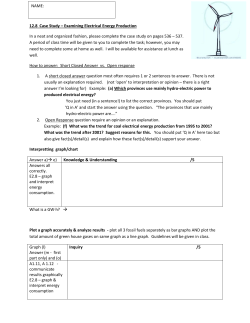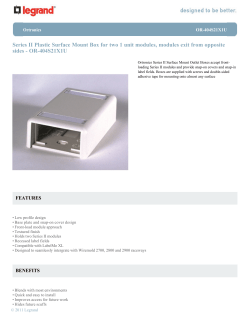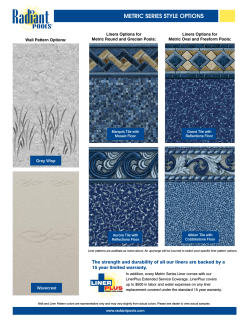
ABCs of Science Review PART 1: METRIC SYSTEM Vocabulary
ABCs of Science Review Why review? Because you have a quiz on __________!! What you’ll find below is the important stuff. PART 1: METRIC SYSTEM Vocabulary: Use the words in the box to fill in the blank and answer the riddle below 1. Instrument used to find mass. _ _ _ _ _ _ - _ _ _ _ _ _ _ _ _ _ _ 21 17 2. Metric unit for length _ _ _ _ _ WORD BANK 20 3. Amount of space an object takes up _ _ _ _ _ _ Absolute zero Celsius Centimeter Cubic centimeter Displacement Graduated Cylinder Gram LxWxH Liter Kilogram Mass Meniscus Meter stick Milliliters Meter Newton Standard Triple-beam balance Volume Weight 16 4. A fixed quantity used by everyone when measuring _ _ _ _ _ _ _ _ 10 5. Metric unit for mass _ _ _ _ 15 6. Instrument used to measure volume _ _ _ _ _ _ _ _ _ _ _ _ _ _ _ _ _ 6 8 7. The Kelvin temperature scale is based on _ _ _ _ _ _ _ _ _ _ _ _ 25 19 8. 1 meter = 100 _ _ _ _ _ _ _ _ _ _ _ 4 9. Metric unit for weight _ _ _ _ _ _ 5 10. Metric unit for liquid volume _ _ _ _ _ 3 11. Amount of matter in an object _ _ _ _ 26 12. Measure of the force of gravity acting on an object _ _ _ _ _ _ 18 13. One of the metric units for temperature _ _ _ _ _ _ _ 11 1 14. 1 liter = 1,000 _ _ _ _ _ _ _ _ _ _ _ 7 24 15. The name of the “bubble” in a graduated cylinder _ _ _ _ _ _ _ _ 22 16. 1000 grams = 1 _ _ _ _ _ _ _ _ 12 17. Instrument used to measure length _ _ _ _ _ _ _ _ _ _ 14 18. 1 milliliter = 1 _ _ _ _ _ _ _ _ _ _ _ _ _ _ _ 13 19. Method for finding the volume of an irregular solid _ _ _ _ _ _ _ _ _ _ _ _ 23 9 20. Formula for calculating volume _ x _ x _ 2 Why were the teacher’s eyes crossed? _ _ _ _ _ _ _ _ _’_ _ _ _ _ _ _ _ _ _ _ _ _ _ _ _ _ ! 1 2 3 4 5 6 7 8 9 10 11 12 13 14 15 16 17 18 19 20 21 22 23 24 25 26 Metric Math: Convert the following. 21) 24 cm = _____________ km 25) 50 mm = _____________ cm 22) 3.8 mL = _____________ dL 26) 0.42 hL = _____________ mL 23) 1,000 g = _____________ kg 27) 0.75 cm = _____________ m 24) 80.3 dag = _____________ kg 28) 3,200 mg = _____________ g PART 2: SAFETY For the quiz, review the safety rules. Below, answer True or False (please write out the entire word). 29. It is always ok to goof off in the science classroom during a laboratory. __________ 30. Any time chemicals, heat or glassware is used, students will wear safety glasses. __________ 31. Report any accidents to Ms. Wiggin, no matter how trivial it may appear. __________ 32. Return all unused materials to their original containers. __________ 33. Clean up broken glass by picking it up with your fingers and dumping it in the trash can. __________ 34. If you don’t know understand the directions: guess! __________ 35. Never leave a lit candle unattended, unless of course it’s lunch time. __________ PART 3: SCIENTIFIC METHOD Ok, so you begin noticing that your dog is shedding everywhere. That gets you wondering, why do dogs and cats have hair in the first place? Lucky for you, your amazing 8th grade science teacher just taught you all about the scientific method and you decide to set up an experiment. Step 1. Observation Example My dog (or cat!) is shedding everywhere. 2. Ask a question 2.5 Research the question Why do dogs and cats have hair? How could you research this? What is your hypothesis? 3. Form Hypothesis How could you test your hypothesis? What kind of procedures may you have? 4. Create and conduct Experiment Experimental Variable (what you’re changing): ____________________________________ __________________________________________________________________________ Measured Variable (what you’re measuring): ______________________________________ __________________________________________________________________________ Controls: __________________________________________________________________ __________________________________________________________________________ How could you analyze your results? 5. Analyze Results Once conclusion could be… 6. Form Conclusions 7. Recommendations & Communication How would you share your results? Are there more experiments that should be conducted?
© Copyright 2025





















